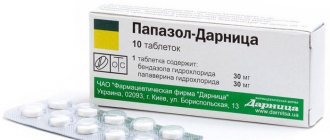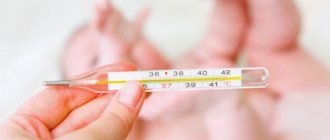Measuring basal temperature helps not only to track the beginning and end of different phases of the cycle, to calculate the most favorable days for conception, but also to draw conclusions about the health of the reproductive system. BT indicators that are within normal limits indicate a favorable hormonal background, the absence of inflammatory processes, and hidden gynecological pathologies. Basal temperature before menstruation can give a woman information whether fertilization has occurred in this cycle, and whether the early stage of gestation is proceeding normally if pregnancy does occur.
Determination of basal temperature
Basal temperature is the indicators obtained during measurements with a thermometer on the surface of the mucous membranes of the body. Translated from Greek, the term basal is translated as basic, meaning thermometer marks that are closest to the physiological ones found inside the body. Natural BT is recorded in healthy girls who do not have reproductive abnormalities or hormonal imbalances.
Today, many women have abandoned the method of measuring basal temperature, although it allows one to accurately determine the stage of the monthly cycle, identify the most suitable days for fertilization, and provide the gynecologist with a lot of information about the condition of the reproductive organs.
You can obtain reliable BT indicators by taking measurements in a calm state, in one of the natural holes:
- mouth;
- vagina;
- rectum.
Measuring the temperature in the armpit is not very informative, since it reflects only external indicators, which rarely rise above 36.6 °C in the absence of pathologies.
Basal temperature and ovulation
Typically, many women use basal temperature readings to determine the time of ovulation. For this purpose, it is better to take measurements in the anus. The readings of a thermometer placed in the mouth or vagina will not provide the required accuracy.
In addition, it should be borne in mind that basal temperature may change due to the influence of certain external factors:
- if you are sick or have had severe fatigue before;
- if you drank a large amount of alcohol the day before;
- if you suffered from insomnia or went to bed very late;
- if there was sexual contact within 6 hours before measurement;
- if you are taking any medications.
A chart of readings will help facilitate the process of establishing the ovulatory phase. So, if the average basal temperature (not the one you measured before your period) is 36.5 degrees Celsius, and then sharply crosses the border of 37 degrees, the desired ovulation has most likely occurred.
If you take readings very carefully, you will most likely notice that there was a slight decrease in temperature immediately before. If a kind of zigzag appears on the graph, this is a sure sign that an egg has formed and is beginning to move through the ovary to the uterus.
With an average cycle length of four weeks, ovulation occurs on the 12th or 14th day.
Goals of its measurement in gynecology
Usually they draw up graphs of basal temperature before menstruation and find out what it should be for women who want to quickly get pregnant and give birth to a child. They simultaneously use several methods to calculate the most favorable days for fertilization.
Menstruation cycles
The base temperature allows us to draw a conclusion about how the hormonal background has changed and how a certain cyclic stage affects it:
Follicular phase
The beginning of the first phase is noted on the first day of menstruation; it normally lasts 14 days. At this time, follicles grow in the appendages, one of which will become dominant and displace the others - it will be the carrier of a mature egg, ready to merge with a sperm. Just before ovulation, BT decreases sharply, since estrogen does not have such a significant effect on indicators as progesterone.
Luteal phase
Before menstruation, women who want to become pregnant can judge whether conception has occurred by BT indicators obtained in the second phase of the menstrual cycle. Thanks to the hormone progesterone, an accelerated growth of the basal marks of the thermometer occurs - a thick epithelial layer is created inside the uterus, capable of retaining the fertilized gamete so that gestation continues.
In the absence of conception, the basal temperature measured before menstruation will become lower as the corpus luteum, formed to support pregnancy and produce progesterone, atrophies. A drop in the level of the hormone in the blood reduces BT and the woman can independently conclude that pregnancy has not occurred.
BT in the first phase of the cycle
The first phase of the menstrual cycle is called follicular, or menstrual.
The first day of the cycle is considered the first day of menstrual bleeding. Typically, the temperature in the follicular phase is low, less than 37C in the rectum.
The duration of the phase is about 14 days. The end of the first phase corresponds to the moment the egg leaves the follicle - ovulation. Before ovulation, BT normally decreases, and after it increases, which is due to the production of the hormone progesterone by the corpus luteum. The corpus luteum forms at the site of the ruptured follicle and produces progesterone within 10-12 days.
Rules for measuring BT at home
In order to qualitatively track how many days before the start of menstruation BT drops, whether it increases immediately after ovulation (whether the reproductive organs fully perform their functions), it is important to strictly follow the rules for measuring basal indicators:
- Measure your temperature immediately after waking up if you have slept continuously for 5–6 hours in a row.
- Try to take measurements at the same time with an interval of no longer than half an hour, preferably during the maximum peak of hormone concentrations (from 05 to 07 am).
- Use one thermometer, preferably an ordinary mercury one - it is more accurate and does not give errors.
- Place the thermometer nearby so as not to get up and make sudden movements (you need to shake it off first in the evening).
- After waking up, it is forbidden to move intensively, go to the toilet, or even stretch sharply in bed.
- Hold the electronic thermometer in the anus for 3 minutes, the mercury thermometer for at least 5–7 minutes, immediately write down the result in a notepad.
- Immerse the thermometer into the anus to a depth of 2–3 cm, after lubricating it with baby cream, oil or Vaseline.
- Do not have sex, stop eating salty, fried and fatty foods, fast food 4-5 hours before measuring BT.
If the thermometer column is at a dubious value, you need to record the lower division in a notepad. In the event of any incident, if a woman got out of bed in the morning, took strong sleeping pills before bed, was nervous or violated her routine, this should be recorded.
Measuring basal body temperature
To correctly draw up a schedule for measuring basal body temperature, you should adhere to the following rules:
- control measurements must take place daily, always at the same time;
- indicators should be measured immediately after waking up;
- sleep should be more than 3 hours;
- indicators must be measured no later than 8 am;
- a medical thermometer must be prepared in advance, leaving it somewhere near the bed;
- it is better to use the same thermometer;
- Before measuring your temperature, you should not get out of bed, sit down, or engage in any physical activity;
- The temperature should be measured for at least 5 minutes in a stationary position;
- the obtained data are marked on the graph;
- The schedule is maintained over three to four cycles.
This schedule helps women better navigate the processes occurring inside her body. It is worth remembering that due to some factors the schedule risks being inaccurate. Errors can be introduced by:
- diseases;
- physical fatigue;
- nervous tension;
- drinking alcohol on the eve of measurement;
- sleep less than 6 hours;
- sexual intercourse shortly before the control measurement;
- taking a number of medications.
All data must be recorded and a calendar maintained. The degree scale is usually marked from 35.7 °C to 37.2 °C.
Norms of temperature indicators in different phases of the cycle
In the table below you can see the norm of BT before menstruation, during the period of bleeding and immediately after its end. Using this data, you can calculate the ovulatory phase and select a favorable moment for conception.
| Cycle phase | Day of the cycle | Phase control agents | BT indicators that should be normal |
| Follicular | 1–13 | Estrogen, follicle-stimulating hormone | 36.3–36.5 °C |
| Ovulation | 14–15 | Estrogen, luteinizing hormone | Decrease to 36.2–36.3 °C Follicle opening 36.4–36.7 °C At the end of ovulation 37-37.4 °C |
| Luteal | 16–28 | Progesterone | 37.1–37.5 °C |
During menstruation
Normal basal temperatures for menstruation are 36.7–37 °C, since the influence of progesterone, which makes the endometrium of the uterus loose and ready for the introduction of a fertilized gamete into it, has not yet ended. During menstrual periods, many women feel lethargic, lack of strength, and suffer from headaches and nausea.
Symptoms appear because menstruation is a kind of stress for the female body; a lot of fluid and blood are lost, with which accumulated toxins come out. On the third day of menstruation, basal rates drop to 36.4–36.5 °C, and on the fourth and fifth days they become even lower – 36.2–36.3 °C.
Graph dynamics are normal
Statistics say that the menstrual cycle of a healthy woman is on average 28 days. The basal temperature indicators are as follows:
- 36.3 °C - one day before the end of menstruation;
- 36.6 - 36.9 °C - during the follicular phase, until the middle of the cycle;
- 37.0 - 37.4 °C - during ovulation;
- 37.0 °C - a few days before the start of menstruation;
- the difference between the follicular and ovulation periods is 0.5°C.
Reduced production of estrogen hormones at the beginning of the phase leads to an increase in basal body temperature. At this time, the necessary conditions are created for the maturation of the egg. The chance of getting pregnant during this period is very low.
If the menstrual cycle has certain differences from the statistical average, the changes are reflected in the phase before the thermometer begins to increase; it either lengthens or shortens. In this case, the ovulation period will last about 2 weeks (with an error of 2 days).
If the rectal temperature before menstruation is above 37 ° C, this may indicate pregnancy. You can verify this in the case when the mark remains above the number 37 for several days longer than the phase characteristic of the body from the moment after ovulation until the start of menstruation.
To do this, you should monitor the dynamics of the graph of the second phase of the cycle.
Pregnancy may be indicated by a stable graph when the graph shows high temperatures for 18 days.
What should be the rectal temperature before menstruation can be understood by following the graph. A few days before they begin, its indicators gradually decrease. Rectal temperature during menstruation (by the time it begins) drops to 37 °C.
After menstruation
At the end of menstruation, the follicular phase is in full swing. Under the influence of estrogen and follicle-stimulating hormone, follicles grow, in one of which the egg will mature. These hormones do not have a strong effect on thermoregulation processes in the pelvis, which is why the rectal temperature will remain between 36.4–36.5 °C. The period during which the gamete leaves the dominant follicle and enters the uterus is called the low temperature phase. If a woman notes 36.3 °C on the thermometer, it means that ovulation will occur after 1–2 days.
During the ovulatory phase, the thermometer will rise by 0.2-0.4 °C - this time is the most favorable for sexual intercourse and fertilization of the egg by sperm. Immediately after ovulation, the normal temperature is 36.9–37.2 °C. If you manage to have intimate contact within 24–48 hours while the gamete is in the uterus, this will lead to pregnancy.
Temperature changes
If, in a normal state of health, the temperature decreases before menstruation, then what might its increase indicate?
After ovulation, the process of changing the production of the hormone progesterone begins, which has a strong effect on the thermal regulation center in the brain. In such a case, some women may experience a slight increase in temperature about seven days before the start of their period. After the start of the cycle, the temperature returns to its normal state. It is worth noting that not many people experience such a reaction.
Also, rectal temperature parameters before the start of the menstrual cycle may increase due to pregnancy.
An elevated temperature, more than 37 degrees, at the very beginning of menstruation opens up the possibility of identifying some pathological changes. These include:
- inflammation in the uterine area (endometritis);
- progesterone deficiency;
- inflammation of the ovaries.
Before your period starts
What should be the basal temperature before the onset of menstruation and during pregnancy - if fertilization does not take place, BT will gradually drop to 36.7–36.9 ° C, and after the start of the critical days it will drop even more.
If conception does occur, this fact can be suspected by the elevated base temperature that persists until menstruation - 37-37.5 °C.
In a situation where pregnancy has occurred and while waiting for the next menstruation, which will not come, a woman can note the following graph of temperature fluctuations:
- Day of fertilization - 36.5–36.7 °C (it is not yet possible to determine that the gamete has merged with the sperm using BT; you need to wait 7–10 days for the release of the fertilized egg and its implantation into the uterine wall).
- Introduction of the embryo into the endometrium - basal levels decrease to 36.3–36.5 °C (implantation retraction).
- 2–4 days after implantation of the fetus into the uterus - BT levels increase to 37 °C.
- The next 1–2 weeks – the temperature will not drop below 37 °C; normally, after conception, the thermometer shows up to 37.4–37.5 °C.
If a woman records an elevated BT level for almost a week in a row on the eve of the expected menstruation and wants to quickly find out whether conception has occurred, she should donate blood to determine the amount of hCG. This test is the most sensitive to hormone levels, unlike the test, and will show conception after 7-10 days.
Features of measurements
What can you find out using a basal temperature chart?
Any woman, upon reaching puberty, dreams of having an ideal cyclic process, knowing the time of ovulation, in order to become pregnant as planned or, conversely, to prevent unwanted conception. For this purpose, along with ovulation tests and other methods, rectal temperature measurement is widely used. That is why the question of what is the normal basal temperature before menstruation, what should it be during the release of the cell and the standards for both phases is very relevant in the lives of girls. Using a graph you can identify the following points:
- whether the follicle is maturing;
- day of ovulation;
- hormonal disbalance;
- day of future menstruation;
- onset of pregnancy.
What is the basal temperature before menstruation (normal)
Before determining what the basal temperature before menstruation is normal in your cycle, let us remind you that measurements should be taken for at least 3-4 months to ensure the reliability of the values obtained and certain rules should be followed:
- Measurement time is 5-7 minutes with a mercury thermometer or 1 minute with an electronic one;
- Use the same thermometer, shaking it off in the evening;
- Do the procedure in the morning, immediately after 6 hours of restful sleep, without getting out of bed and without making sudden movements, preferably at the same time;
- Enter the data into a chart, under which note the slightest deviations in your usual lifestyle (colds, stress, physical overexertion, alcohol consumption, etc.).

A well-drawn and correctly read schedule will help identify the problem at an early stage and eliminate it without consequences.
Why does basal temperature remain elevated before the onset of menstruation?
Normally, the basal temperature should drop before menstruation from 37 to 36.7-6.8 °C - if this does not happen, in addition to pregnancy, one can suspect the presence of certain pathologies that support elevated BT levels:
Inflammatory processes in the pelvis
Inflammation leads to disruption of thermoregulation, a rush of blood to the appendages and uterus, which is why BBT remains at a higher level than it should be.
Spontaneous ovulation
In case of sudden hormonal disruptions, the release of the egg occurs much earlier or later than the required time. If just before the onset of menstruation, BT is increased to 37 °C, this indicates a recent entry of the gamete into the uterus and an expected delay in menstruation. You should see a doctor to have your hormonal levels examined.
Repeated ovulation
It happens that BBT decreases closer to the beginning of menstruation to the required level of 36.8 °C, the woman becomes convinced that conception has not occurred and waits for the critical days, and the thermometer again rises above 37.3 °C. The symptom is caused by repeated ovulation - a rare occurrence when two eggs mature in the follicles at once. If one of them has already entered the uterus and has not been fertilized, the second leaves the ovary just before menstruation, creating a repeated peak of BT.
BT levels above 37.5 °C before menstruation are pathological and require a doctor’s comments, since they indicate the presence of an acute inflammatory process in the pelvis.
How to measure
Measuring basal temperature is quite easy: this method uses a familiar thermometer. However, it is advisable to determine the temperature not in the axillary cavity, but in the rectum, vaginal area or oral cavity.
To avoid any errors in the temperature determination process, some rules should be taken into account:
- measurements should begin on the first day of the menstrual cycle;
- in the case of rectal measurement, it is not recommended to change the method, because the graph will be uninformative;
- When determining the temperature rectally or in the vagina, it is advisable to take into account that it takes three minutes to measure. With the oral method, the interval increases to five minutes;
- indicators should be determined in the morning before getting out of bed;
- It is necessary to carry out the presented manipulations at the same time. Because in case of fluctuations of more than 30 minutes, the temperature can no longer be indicative;
- It is possible to use both a digital and a mercury thermometer to determine indicators. However, it is highly undesirable to change it throughout the cycle. When using a mercury thermometer, it must be shaken off before going to bed.
One of the most proven and accurate ways to determine the onset of menstruation, possible pregnancy and other processes is the rectal temperature. That is why every woman should know everything about her fluctuations, methods and rules of measurement.
Temperature indicators at conception
What will be the body temperature during pregnancy in the early stages before the delay? It will not be possible to determine whether fertilization occurred in this cycle by basal temperature a week before the start of menstruation - at this stage, while the active stage of the luteal phase lasts, under the influence of progesterone, the thermometer readings will be elevated. Later, 7–10 days later, just before the onset of menstruation, the thermometer marks will be able to more confidently indicate whether pregnancy has taken place.
In women with an unstable long cycle (32–35 or more days), menstruation may come earlier or later, which is why it is not always possible to guess whether fertilization has been completed before the delay. By the time a woman begins to worry that there has been no menstruation for more than 35 days in a row, she may be diagnosed as 1.5-2 weeks pregnant. BT standards in the early stages and the reasons for deviations are shown in the table.
| Fertilization period in weeks | Obstetric time in weeks | Standard BT in OS | Factors influencing changes in normal BT |
| 1 | 3 | 36,9–37,4 | Decrease – threat of spontaneous abortion, increase in temperature – acute inflammatory process |
| 2 | 4 | 37,2–37,6 | |
| 3 | 5 | 37,2–37,7 | |
| 4 | 6 | 37,2–37,7 | If the readings drop and then sharply increase to 37.9–38 °C, a frozen pregnancy can be suspected |
Normal basal temperature readings
The menstrual cycle consists of several phases, and each of them is characterized by its own BT.
In the absence of pregnancy and inflammatory disease, the basal temperature begins to decrease a week before menstruation. This meaning varies from woman to woman due to individual characteristics. Important information is the temperature difference between the phases.
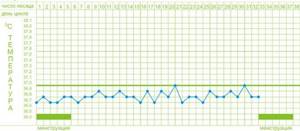
The follicular phase lasts from 7 to 22 days. At this time, the eggs mature. Next comes the ovulatory phase. Its period is very short - 36 - 48 hours. During ovulation, the egg is fully mature for fertilization. In the luteal phase, the follicle bursts and the corpus luteum is released. The stage lasts 11 – 16 days. Its place in the menstrual cycle is before bleeding.
The concentration of sex hormones in each phase of MC fluctuates. The exact basal temperature is determined by the levels of progesterone and estrogen. The permissible fluctuation between phases is at least 0.4 - 0.5 degrees. The normal duration of the menstrual cycle for a healthy woman is 21–35 days. Ideally, your period comes once every 28 days.
Here are the average basal temperatures:
- Before ovulation – 37.2 – 37.4 degrees.
- On the days of ovulation – t reaches 37 – 37.2°C.
- After the release of a mature egg, the temperature remains at 37°C.
- The day before your period, BT rapidly drops to 36.7 – 36.9°C.
- On menstrual days – 36.9 – 37°C.
- End of bleeding – 36.4 – 36.7°C.
Video:
Pathological marks of basal temperature
The basal temperature before the onset of menstruation does not always remain in normal ranges, both during conception and outside of pregnancy. If a woman regularly writes down her BT readings in a notebook and plots graphs for several cycles in a row, she should consult a specialist when she notices serious deviations in the thermometer marks. A temperature indicating conception of 37-37.5 °C on the eve of menstruation is a reason to immediately confirm or deny the fact of pregnancy using a blood test or ultrasound diagnostics.
Basal temperature during PMS
In order to correctly take temperature readings before menstruation, the following procedure should be followed:
- measurements are taken only in the morning at the same time;
- the period of sleep preceding measurement should not be less than 3 hours;
- This procedure is performed only in a lying position.
- The schedule for changes in readings should be as follows.
- The basal temperature immediately after the end of menstruation should be between 36.5 and 36.9 degrees Celsius. Then, towards the middle of the cycle between menstruation, it decreases somewhat, after which there is a sharp jump before menstruation. This indicates the normal functioning of the body and the timely arrival of the ovulatory phase.
Why rates may decline
A woman should monitor monthly how many days before the start of her period her basal temperature drops in order to be ready to diagnose possible fertilization - usually BT levels decrease one day before menstruation. If the thermometer confidently showed 37.5 °C for almost a week, which indicates successful fertilization, and then the readings sharply decreased, this may mean:
- threat of spontaneous abortion;
- beginning miscarriage;
- frozen pregnancy in the very early stages;
- progesterone deficiency.
Lower than normal basal levels can be individual for a woman. If during ovulation she records a temperature at a peak of 36.7–36.8 °C, then a figure of 36.9–37.1 °C after conception is not a deviation from the norm for her.
Indicators during ovulation
Ovulation is the release of an egg from the follicle. This occurs due to a surge of luteinizing hormone (LH) in the pituitary gland. This is reflected on the BT chart as follows:
- a day or two before ovulation there is a sharp rise in temperature up to 37.5 degrees;
- ovulation - rectal temperature drops to 36.7-36.8 degrees, after which it should rise again if the woman’s body produces a sufficient amount of progesterone.
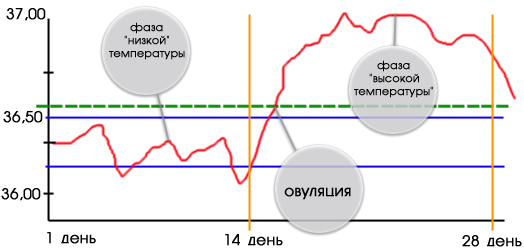
If the rise on the graph is smooth and not sharp, this may indicate an inferior egg or an insufficient level of the LH peak. A sharp rise and then a fall (two peaks) indicates the death of the egg. The absence of a rise in temperature generally indicates the absence of ovulation, which may be associated with temporary factors affecting the body, as well as with serious hormonal disorders and hereditary diseases.
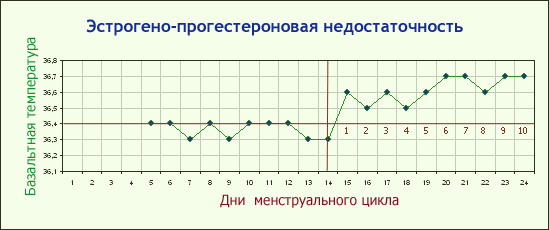
Increased basal levels before menstruation
The answer to the question of what temperature should be in the rectum before menstruation depends on whether pregnancy has occurred in the current cycle. If conception has occurred, normal values should be 37–37.5 °C; outside of pregnancy, before the onset of menstruation, the thermometer should show 36.7–36.9 °C.
In pregnant women, an increase in basal levels to 38 °C indicates the following problems:
Ectopic pregnancy
For a period of 2–3 weeks, it may manifest itself as nagging pain in the lower abdomen, mainly on one side, general hyperthermia, weakness, and decreased blood pressure. Later, bloody vaginal discharge of a spotting nature joins the symptoms, and the pain intensifies. At this stage, it is important to go to the hospital immediately to avoid pipe rupture and internal bleeding;
Risk of miscarriage
Symptoms of the threat include aching pain in the abdomen, radiating to the lower back, deterioration in well-being, and weakness. If you go to the hospital on time, the doctor can prescribe progesterone medications to the patient to prolong pregnancy. Outside of pregnancy, if the basal temperature has increased, this may indicate acute and chronic inflammatory processes (in the pelvis, intestines, stomach). Such pathologies include adnexitis - inflammation of the ovaries. The disease is characterized by symptoms of nagging pain in the abdomen, pain during bowel movements and urination, and an increase in general body temperature to 37.5–38 °C. Sometimes the patient’s condition deteriorates so much that she requires urgent care in a hospital setting.
Also, an increase in basal levels to 38 °C causes diseases:
Endometritis
Acute bacterial infection affecting the endometriotic layer of the uterus. Develops after abortions, miscarriages, diagnostic curettages and operations on the uterus. It manifests itself as weakness, release of sticky sweat, and a sharp deterioration in health. There may be bloody discharge mixed with pus or mucus from the genital tract.
Sexual infections
These include thrush, chlamydia, ureaplasmosis, mycoplasmosis, trichomoniasis, and gonorrhea. In addition to discomfort in the lower abdomen, a woman experiences vaginal discharge with a repulsive, unpleasant odor and an unnatural color (green, yellow, gray, white with a cheesy consistency);
Diseases of the genitourinary system
With cystitis, inflammation of the bladder walls occurs. The lady cannot urinate normally; there is a constant feeling of fullness in the bladder. When going to the toilet, cutting pain occurs in the lower abdomen and a burning sensation in the urethra. Body temperature rises to 37.5–38 °C.
A high basal temperature on the eve of menstruation and when it has not started on time should be a reason to consult a doctor, especially if there are dangerous signs: deterioration in health, weakness, acute pain in the lower abdomen.
Basal temperature measured in compliance with all the rules will allow a woman to determine the presence or absence of problems with the reproductive organs and calculate days favorable for conception. It is recommended that every girl learn how to correctly draw up a schedule in order to contact a specialist in time if sudden deviations from the norm appear.
Basal temperature values before menstruation
Basal temperature before menstruation: why measure it?
First, let's look at the definition of the term. We all know well that the normal temperature in the armpit should be 36.6 °C. If our body temperature is lower or higher than normal, we immediately feel unwell and want to take sick leave. But basal temperature does not affect us that way. We will not be able to feel even a sharp temperature drop of half a degree. So, basal temperature is, roughly speaking, the temperature of our mucous membranes, which characterizes some of the processes occurring inside our body. It’s very interesting to observe this as a doctor, but we are not all doctors. Why might such information be needed by an ordinary person, or more precisely, a woman, since mostly data on changes in BT is important to her? The fact is that basal temperature changes during the period of ovulation, therefore, if there is a question about family planning, then mastering this method is important for a woman who wants to get pregnant.
We measure BT and build a graph
Measuring basal temperature is quite simple: this method uses a regular thermometer. Just measure the temperature not in the armpit, but in the rectum, vagina or mouth. By measuring your temperature before your period, you can find out how soon your next period will come. And, by the way, if ovulation has occurred, this can be determined during the period before menstruation.
But I wonder what the basal temperature (BT) before menstruation will be in the absence of pregnancy, with positive ovulation? What do the numbers on the thermometer characterize? Let's look at various situations and possible reasons for deviations from generally accepted norms.
Basal temperature before menstruation 36.9°C
and there are no jumps in values on the graph in the second half of the menstrual cycle. This indicates the absence of a mature egg. This cycle was probably anovulatory. But this does not give grounds to diagnose a woman with infertility. Since even 20-25 year old women with a good ovulatory reserve can experience such cycles 2-3 times a year.
If the basal temperature before menstruation is 37.0, 37.1, 37.2
degrees, then this may indicate pregnancy. And, most likely, this is what happened. And if the rise in BT was before the expected menstruation, perhaps they will no longer be, at least in the next nine months.
Basal temperature before menstruation 37.3°C
a little higher than expected. Perhaps a deviation from the norm is associated with nervous overstrain, inflammatory processes in the body. In this situation, it is advisable to consult your doctor.
Basal temperature before menstruation 37.4°C
often associated with estrogen deficiency. It is unlikely that you will be able to get pregnant during a period of elevated basal temperature. But you shouldn’t put off going to the doctor. The gynecologist can refer you to an endocrinologist for an appointment. You may have to wait a little while planning your pregnancy. It is important to identify the cause of such a high basal temperature.
If you decide to use this method when planning a pregnancy to determine possible reasons for the lack of conception or to determine the day of ovulation, remember that a stable (for at least 3 menstrual cycles) increase in basal temperature before menstruation, as well as its decrease below 36.5 ° C - criteria that should not be ignored. If you are trying to get pregnant, then any changes in the temperature chart that you do not understand should be explained by your gynecologist.
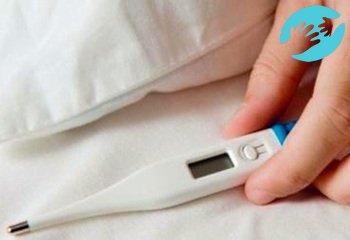
The basal schedule allows you to observe the normal course of processes in the female body. Today we will look at the question of what is the basal temperature before menstruation and what values are typical for the functioning of the reproductive system at different stages of the cycle, and especially before the onset of menstrual periods.

